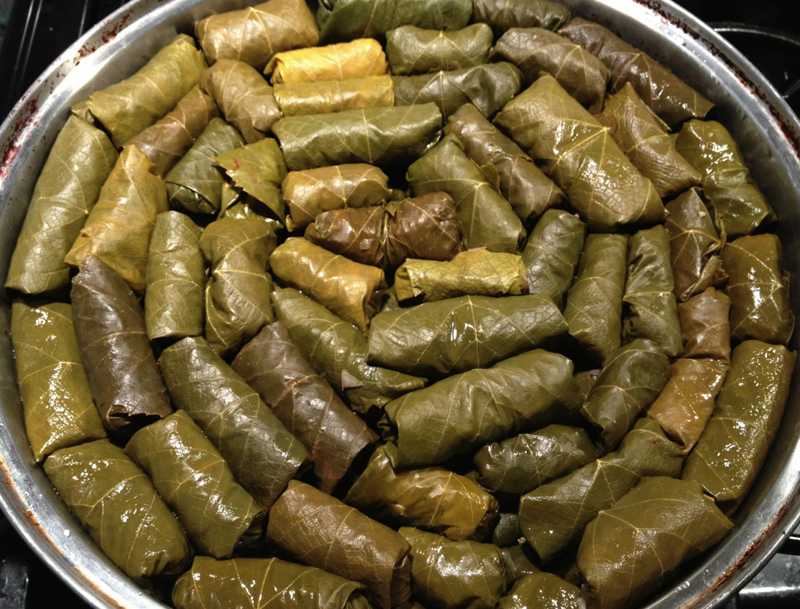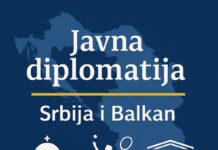“I don’t think the war strategy has ever worked for humanity, but after thousands and thousands and thousands of years of earth controlled by humans, war still seems to be the answer? I hope one day, food will be the answer.”
– José Andrés[1]
Dolma is a simple, albeit time-consuming, dish to prepare. Grains or ground meat, rice, tomato paste, spices, and veggies (to stuff) or leaves (to wrap) are usually all there is to it. It comes in all shapes, colors, and sizes: from stuffed eggplants, tomatoes, peppers, and zucchini to carefully wrapped grape or cabbage leaves. Dolma can be made with beef or lamb, and there is a vegetarian option, too, with lentils, peas, or chickpeas instead. This tasty morsel, which has joined the list of globalized “ethnic” foods (usually marketed as Mediterranean/Middle Eastern in the West), is characteristic of many traditional cuisines in the area that extends from Central Asia to the Balkans, and from North Africa to Russia. The various permutations of the dolma recipe reflect its transformation and adaptation by various peoples who have inhabited that vast territory over millennia.
The variety and pervasiveness of dolma have led to disputes among countries of the region regarding the origins of the dish. Where did the dolma originate and whose “national cuisine” does it represent? This paper examines the food fight raging between Armenia and Azerbaijan – two nations in the South Caucasus that fought a bitter war in the 1990s and are still in a frozen conflict with each other. It posits that despite the intensity of gastronationalism in the region, gastrodiplomacy can serve as an additional tool for achieving and maintaining peace between the Armenians and the Azerbaijanis.
Gastronationalism
Culinary traditions and foodways, just like anthems or flags, are among the fundamental building blocks of national identity. Nations define themselves through things that give group members shared experiences and generate solidarity. Food, as a material artifact of culture, is no exception.[2] As a basic necessity for sustenance and survival, food provides “links between social actors and their cultural pasts, shared bonds of familial or religious identity, and narratives of organizational identity.”[3] Culinary culture also recreates national myths and memories,[4] functions as a language to articulate “notions of inclusion and exclusion, of national pride and xenophobia,”[5] and, therefore, acts as “a boundary-marker between one identity and another.”[6]
In a rapidly globalizing world where claims of authenticity and exoticism provide a competitive edge for goods on the global market, the importance of national signifiers for food products has increased further.[7] Michaela DeSoucey has coined a term for the combination of this phenomenon with that of identity.[8] Gastronationalism, she suggests, describes the “use of food production, distribution, and consumption to create and sustain the emotive power of national attachment” that is later used in the production and marketing of food.[9] Yet, much like other national symbols that rarely follow the strict rules of separation and the neat lines of political borders, international disputes over the “ownership” of certain foods and dishes are increasingly common. Some of the more prominent of these cases include the fights over hummus (as well as tabouleh, labne, or falafel, to name but a few) between Israel and Lebanon,[10] kimchi between China and South Korea,[11] and “Turkish” delight between Cyprus and Turkey.[12] There is certainly an economic justification to patenting foods as one’s national dish, as it can help promote sales and provide exclusive access to markets. However, underlying most if not all of these fights is also a fundamental contestation over identity linked to territorial and historical disputes.
Making Dolma a Matter of National Security
Conflicts regarding the origins of various cultural artifacts in the Southern Caucasus has been simmering for years over issues like carpet patterns, winemaking, horses, musical instruments, and dog breeds, to name but a few. The culinary controversies gained prominence in late 2011, when UNESCO decided to add keshkek, an Anatolian stew made with chicken and wheat berries, to its list of “Intangible Heritage” on behalf of Turkey.[13] Armenians, who call the same dish harisa and consider it to be their own, were outraged at the decision and set out to find ethnographic evidence to overturn it.[14] That served as a catalyst for the mobilization of several NGOs and youth groups in the country, which started calling for greater government involvement in reclaiming Armenia’s intangible heritage, as well as advocating for a more coordinated effort to preserve and promote Armenia’s culinary traditions.[15]
Those behind the Armenian initiative construed this effort in terms of a greater struggle for cultural survival and national security. As historian and analyst Ruben Nahatakyan stated in an interview at the time:
We are in the middle of the war of civilizations […]. [O]ur not so friendly neighbors are trying to rob the entire Armenian highland, both the territories that are part of the Armenian Republic and those that aren’t. […] A neighbor will always take what’s yours if you don’t protect it; and today we are dealing with neighbors who are acting upon a well-thought strategy, and we keep failing to resist their plots.[16]
The activists involved in this effort have promised articles and films on various Armenian traditional dishes, international campaigns that raise awareness and get recognition, as well as various festivals to engage the public at large.
Amidst this fight, dolma seems to have gained a special status. For the past three years, the Development and Preservation of Armenian Culinary Traditions (DPACT) NGO has overseen the organization of an annual Dolma Festival as a way of “disproving the wrong opinions that tolma [sic] has Turkish roots.”[17] At the first festival, head of DPACT Sedrak Mamulyan noted that the choice of location for the festival – Sardarapat, a battlefield of major historical significance – was not accidental, since Armenians need to develop their “self-defense instinct” in the culinary world, just as they defended their homeland during the battle of 1918.[18] He went on to say that the Armenian cuisine “has served as a donor” to neighboring countries and that at its root, the cuisine of the region is actually Armenian. As evidence to support their claims, some of the chefs participating in the Festival claimed to have taken their dolma recipes from ancient archives, and some from cuneiform records dating back to the 8th century BC found in the Erebuni fortress (on territory of modern-day Yerevan), the capital of the Urartian Kindgom at the time.[19] To prove their dedication to the dish and taking inspiration from their Mediterranean counterparts, who had engaged in bitter competitions over the biggest plate of hummus and the largest piece of “Turkish” delight, participants of the 2013 Festival competed over the longest dolma in an attempt to set a world record, the winner being a 25-foot-long “behemoth.”[20]
Another campaign aimed at primordializing the dolma was an attempt to reconceptualize the etymology of the name, playing on the difference between the spelling – “dolma” and “tolma” – to suggest that dolma means “stuffed,” while tolma means “wrapped” – that is, in grape leaves. A prominent restaurant chef even went so far as to claim that “Tolma is a word that consists of two Urartu language roots, ‘toli’ and ‘ma,’ which mean ‘grape leave’ and ‘wrapped’.”[21] However, it is important to note that the root itself is Turkic and “dolma” in Turkish means stuffed or full of. The word for wrapped, on the other hand, is “sarma,” which is in fact what wrapped grape leaves are called in Turkey and some of the Balkan countries (but, surprisingly, not in Azeri, which has Turkic roots, too). The difference between the spelling of “dolma” and “tolma” can be attributed to the phonological change as a result of the influence of the Russian language in countries like Armenia or Azerbaijan. This is demonstrated with the example in Armenian, where there is a difference between the pronunciation of the first letter, which is harder (“d”) in Western Armenian (spoken in Anatolia and by most of the current Diaspora) and softer (“t”) in Eastern Armenian (of Armenia proper, Iran. and the Former Soviet Union). All the while the spelling of the word remains identical.
These claims enraged the Azerbaijanis who accused Armenians of culinary plagiarism, and elevated the issue to a matter of national security. As a result, the Ministry of National Security established a National Cuisine Center – a watchdog of sorts – charged with “exposing the Armenian lies” about the dishes stolen from Azerbaijani cuisine.[22] Furthermore, the Ministry of National Security, along with the Ministry of Culture and the national Copyright Agency, has been actively involved in publicity campaigns, including film screenings and publications on ethnographic origins and etymology.[23] And to highlight the significance of dolma itself, in 2012 President Ilham Aliyev went as far as to declare it an “Azeri national dish,”[24] effectively denying the claims laid to it by all other nations, including Turkey.
Gastrodiplomacy: An Answer?
The dolma dispute is part of the larger conflict between the two nations, including that over Nagorno Karabakh, which remains unresolved. Writing about the hummus wars, Ari Ariel noted that in circumstances of conflict, those involved in the preparation and the sale of the food on both sides are seen as representatives of their respective communities: “If food and national identity are universally linked, here political dispute and warfare produce a rhetoric of violence that transforms cooks into combatants.”[25] However, beyond just being an extension of the conflict, food can also bring the two sides together – as long as they accept its shared origin. And this is where diplomacy of food can play a major role.
Sam Chapple-Sokol suggests using “culinary diplomacy […] as an instrument to create cross-cultural understanding in the hope of improving interactions and cooperation.”[26] Paul Rockower, however, highlights the need to differentiate between “culinary diplomacy,” which he conceptualizes in terms of high diplomacy between representatives of certain nations and communities, and “gastrodiplomacy,” which is much broader and includes engagement with the public at large.[27] Gastrodiplomacy – “the act of winning hearts and minds through stomachs” – introduces foreign culture through familiar access points such as the sense of taste, and seeks to establish an emotional connection through food.[28] In terms of conflict resolution, gastrodiplomacy can serve as a medium for Contact Hypothesis, a theory suggesting that hostility between groups is “fed by unfamiliarity and separation.”[29] According to the theory, greater contact between the groups, under the right conditions, can bring an end to the conflict by promoting more positive intergroup attitudes. Gordon Allport who developed the Hypothesis identified four major conditions necessary for success: support of respective authorities who would foster the social norms that favor acceptance and ties, promotion of close contact between the members of the two groups, equal status between them, and the presence of cooperative interdependence between the groups to ensure mutual reliance and cultivation of trust.[30] Although these fundamental conditions might be absent in the current Armenian-Azerbaijani relations, given that other channels of resolution to the conflict do not seem to be working, food and, more specifically, dolma diplomacy should be given a chance.
Moving Forward: Can Enemies Become Friends?
Both Armenia and Azerbaijan have been calling for the need to enhance their respective public diplomacy strategies abroad, in order to garner more international support for their stances on the conflict.[31] Despite being few in number, there have also been calls for, and attempts at more engagement with each other through public diplomacy.[32] Gastrodiplomacy can be a potent tool in this latter process, demonstrating commonality and creating a shared, safe space where a conversation can begin. Some projects – such as the Azerbaijani Cuisine Day organized in Nagorno Karabakh by the Helsinki Initiative NGO in 2007 – have met with success, because despite politics and hostility, both nations still enjoy each other’s food.[33] Other suggested projects can include – but are not limited to – joint culinary festivals, cooking competitions with teams from both nations, and cooking shows featuring chefs from both sides cooking common dishes together.
Over time, such activities and projects can bring about the “right conditions” for Contact Hypothesis outlined by Allport. Given the separation between the Armenians and the Azerbaijanis, and their lack of knowledge or understanding of each other, exploring common traditional dishes can help establish the notion that the two sides share quite a bit in common – whether culturally, socially, or historically. Furthermore, engaging in joint projects where both sides have to cooperate to achieve a superordinate goal – such as in case of competitions or festivals – can help the participants overcome their distrust, which can then be used to build further dialogue. In this sense, the effort has high acquaintance potential and promotes cooperative interactions. Equal status is another important condition, since it can disconfirm negative expectations about the other.[34] Sharing a meal – such a dolma – which both sides would prepare together, could establish equality through a common sensory experience, as well as provide an atmosphere of intimacy where a constructive conversation can begin.[35]
Finally, and perhaps most importantly, Allport suggests that social and institutional support is vital for the success of the process, since without a conducive environment of tolerance and acceptance, no dialogue can take place and no achievements can be sustained. It is, therefore, important to ensure state support for such conciliatory measures. Nareg Seferian, an independent analyst and a cosmopolite currently based in Armenia, raises similar concerns. Seferian says that the Nagorno Karabakh issue is fundamentally a political one, where lives and territory are at stake.[36] Therefore, according to him, only a political solution – peace through diplomacy – can be a lasting one. “In order to maintain an atmosphere of neighborliness afterwards, though, I would say that food, among other things, can be used as a common marker. That can only be an afterthought, however.” Onnik Krikorian, a British freelance reporter and photojournalist based in Tbilisi, Georgia, expresses a similar sentiment: “Traveling around Georgia, I’ve seen ethnic Armenians and Azeris share tables full of dolma and other dishes without mention of ‘whose’ they might be. But that’s probably because they’re spared the near constant propaganda in circulation in Armenia and Azerbaijan.”[37] In short, unless the necessary conditions highlighted by Allport are present, success will be questionable, at best. Yet if the conflict is somehow resolved, gastrodiplomacy – along with other forms of public and cultural diplomacy – can be a potent medium for bringing the two nations together.
Conclusion
By no means is gastrodiplomacy suggested here as a solution in itself, especially given the context of a seemingly intractable conflict driven by nationalism and the propaganda of hate on both sides. However, it can serve as a tool for conflict resolution in two ways. Firstly, it can begin a peace from below, starting a movement towards a constructive conversation during which some of the other more difficult issues and fundamental disagreements can be negotiated. Gastrodiplomacy can provide the participants with an inherent understanding that some things are, have been, and should probably be shared: that collaboration and cooperation, and not exclusion or hostility, are the answer to the wider conflict. Secondly, gastrodiplomacy can follow a peace from above – one agreed to on the high, diplomatic level between negotiators and politicians – to establish a friendlier atmosphere on both sides of the border and create the conditions for lasting peace. In both cases, however, gastrodiplomacy can only play a supplementary role. There must be mutual will and recognition for any of it to work.
Cuisine, just like identity, requires a more complex understanding, one that goes beyond mere lines that denote purported national borders on maps. Foodways are constructed over time through constant interaction and communication with others, meshing, reshaping, and often simply borrowing from each other. Labeling foods – especially ones that are popular around the region and more recently, around the world – as “Armenian” or “Azerbaijani,” “Lebanese” or “Israeli,” therefore, reflects a very simplistic understanding of the world, pandering to base nationalistic sentiments and emotions, for the purposes of achieving certain political ends. Gastrodiplomacy can help step beyond this worldview towards the higher goal of cooperation, demonstrating that differences are not truly as great or tangible as they might have been initially presented. After all, as Krikorian notes, “Does it actually matter [who “owns” the dolma], especially when the origins are hard to prove and the whole point is to eat it anyway? […] I’ve seen Armenians and Azerbaijanis share tables numerous times. The toasts are nearly always to peace.”
References and Notes
[1] In Chapple-Sokol, Sam. “Culinary Diplomacy: Breaking Bread to Win Hearts and Minds.” The Hague Journal of Diplomacy 8.2 (2013): 161-83. Print.
[2] Palmer, Catherine. “From Theory to Practice. Experiencing the Nation in Everyday Life.” Journal of Material Culture 3.2 (1998): 175-99. Print. See also Bell, David, and Gill Valentine, eds. Consuming Geographies: We Are Where We Eat. New York: Routledge, 1997. Print.
[3] DeSoucey, Michaela. “Gastronationalism: Food Traditions and Authenticity Politics in the European Union.” American Sociological Review 75.3 (2010): 432–55. Print.
[4] Cho, Hong Sik. “Food and Nationalism—Kimchi and Korean National Identity.” The Korean Journal of International Relations 46.5 (2006): 207-29. Print.
[5] Bell, David, and Gill Valentine, eds. Consuming Geographies: We Are Where We Eat. New York: Routledge, 1997: 168. Print.
[6] Palmer, Catherine. “From Theory to Practice. Experiencing the Nation in Everyday Life.” Journal of Material Culture 3.2 (1998): 188. Print.
[7] Ferguson, Priscilla Parkhurst. “Culinary Nationalism.” Gastronomica: The Journal of Food and Culture 10.1 (2010): 102-09. Print.
[8] DeSoucey, Michaela. “Gastronationalism: Food Traditions and Authenticity Politics in the European Union.” American Sociological Review 75.3 (2010): 432–55. Print.
[9] DeSoucey, Michaela. “Gastronationalism.” The Wiley-Blackwell Encyclopedia of Globalization. Ed. Ritzer, George. Chichester: John Wiley & Sons, 2012. Print.
[10] Ariel, Ari. “The Hummus Wars.” Gastronomica: The Journal of Food and Culture 12.1 (2012): 34-42. Print.
[11] Pham, Mary Jo A. “Food as Communication: A Case Study of South Korea’s Gastrodiplomacy.” Journal of International Service 22.1 (2013): 1-22. Print.
[12] Hadjicostis, Menelaos. “Turkey Less Than Delighted over Candy Trademark Move.” The Houston Chronicle 14 December. 14 2007. Web. 20 October. 20 2013.
[13] Schleifer, Yigal. “UNESCO Decision Helps Start a Turkish-Armenian Food Fight.” EurasiaNet 5 December. 5 2011. Web. 18 October. 18 2013.
[14] Schleifer, Yigal. “Armenia: More Fallout from UNESCO’s Culinary Heritage Decision.” EurasiaNet 7 December. 7 2011. Web. 20 October. 20 2013.
[15] ArmeniaNow. “National Heritage: Initiative Group Forms in Armenia to Protect Non-Material Cultural Values.” ArmeniaNow 5 April. 5 2012. Web. 20 October. 20 2013.
[16] Ibid.
[17] Mkrtchyan, Gayane. “Tolma Festival: Traditional Armenian Ways of Wrapping Meat in Leaves Presented Anew.” ArmeniaNow 15 July 15 2011. Web. 18 October. 18 2013.
[18] Ibid.
[19] Ibid.
[20] Kebabistan. “Armenia: The Dolma Battle Goes On.” EurasiaNet 12 July 12 2013. Web. 18 October. 18 2013.
[21] Mkrtchyan, Gayane. “Tolma Festival: Traditional Armenian Ways of Wrapping Meat in Leaves Presented Anew.” ArmeniaNow 15 July 15 2011. Web. 18 October. 18 2013.
[22] DAY.AZ. “Russia’s Large Food Company Labels Azerbaijani Dish as Armenian.” Today.Az 16 July 16 2009. Web. 22 October. 22 2013. See also O’Connor, Coilin. “Food Fight Rages in the Caucasus.” Transmissions. Radio Free Europe/Radio Liberty 17 January . 17 2013. Web. 18 October. 18 2013.
[23] ANN. “Film About Armenian Plagiarism of Azerbaijani Cuisine Presented in Baku.” ANN.AZ 16 January. 16 2013. Web. 20 October. 20 2013.
[24] O’Connor, Coilin. “Food Fight Rages in the Caucasus.” Transmissions. Radio Free Europe/Radio Liberty 17 January . 17 2013. Web. 18 October. 18 2013
[25] Ariel, Ari. “The Hummus Wars.” Gastronomica: The Journal of Food and Culture 12.1 (2012): 34. Print.
[26] Chapple-Sokol, Sam. “Culinary Diplomacy: Breaking Bread to Win Hearts and Minds.” The Hague Journal of Diplomacy 8.2 (2013): 162. Print.
[27] Rockower, Paul S. “Recipes for Gastrodiplomacy.” Place Branding and Public Diplomacy 8.3 (2012): 235–46. Print.
[28] Ibid.
[29] Brewer, Marilynn B., and Samuel L. Gaertner. “Toward Reduction of Prejudice: Intergroup Contact and Social Categorization.” Blackwell Handbook of Social Psychology: Intergroup Processes. Eds. Brown, Rupert and Samuel L. Gaertner. Oxford, UK: Blackwell Publishers, 2008. 452. Print.
[30] Ibid.
[31] Ismailzade, Fariz. “Azerbaijan Boosts Its Public Diplomacy Efforts.” Eurasia Daily Monitor. Jamestown Foundation 12 August. 12 2011. Web. 22 October . 22 2013. Haratunian, Jirair. “Gap: Armenia Lacks a Public Diplomacy Strategy.” ArmeniaNow 5 May 5 2008. Web. 22 October. 22 2013
[32] Shirinyan, Anahit. “Karabakh Settlement: In Need of Public Diplomacy.” Caucasus Edition 12 April . 12 2010. Web. 22 October . 22 2013. Musayelyan, Lusine. “Appetites Trump Politics.” Caucasian Circle of Peace Journalism 14 December . 14 2011. Web. 20 October. 20 2013.
[33] Schleifer, Yigal. “In Disputed Nagorno-Karabakh, Locals Still Pine after Azeri Food.” EurasiaNet 22 December . 22 2011. Web. 21 October . 21 2013.
[34] Ibid.
[35] See, for example, Shah, Riddhi. “Culinary Diplomacy at the Axis of Evil Cafe.” Salon 9 June 9 2010. Web. 20 October . 20 2013.
[36] Author’s correspondence with Seferian, October. 2013.
[37] Author’s correspondence with Krikorian, October. 2013.
Yelena Osipova is a PhD Candidate in International Relations at the School of International Service, American University, in Washington, DC. Her research focuses on public diplomacy and cross-cultural communication, specifically in Eurasia. She is currently working on her dissertation on the Russian discourse on soft power and public diplomacy.
From Gastronationalism to Gastrodiplomacy: Reversing the Securitization of the Dolma in the South Caucasus
Views: 121














